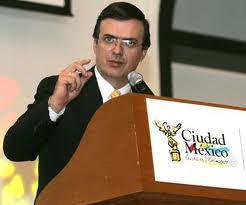As Mexico gears up for next summer’s presidential election, the country’s electoral “lefts” are deeply divided. The mere fact that Mexico’s “lefts” are almost always referred to here in the plural, even when the discussion is limited to the electoral arena, as it is in this brief blog, highlights this division.
are deeply divided. The mere fact that Mexico’s “lefts” are almost always referred to here in the plural, even when the discussion is limited to the electoral arena, as it is in this brief blog, highlights this division.
The conventional wisdom here is that the electoral left, mainly, but not entirely consisting of the Party of the Democratic Revolution (PRD), is divided between hardliners and moderates. The hardliners (duros) are supporting former Mexico City mayor and 2006 presidential candidate, Andrés Manuel López Obrador (AMLO) for the presidency, while the moderates have lined up behind Mexico City’s current mayor, Marcelo Ebrard. The truth of the matter is that the so-called duros and compromisers are divided more by tactical considerations and personal animosities than by questions of governance or political ideology. Both AMLO and Ebrard have governed “from the center,” making use of private-sector alliances to advance progressive goals—from accessible transportation and housing to same-sex marriage. Both are anxious to avoid a public rupture that would certainly weaken the entire left at a time of severe social and economic crisis.
But the fact remains that the PRD is losing ground because the fierce personal and tactical infighting in the party (and within the broader left alliance that includes two smaller parties) has clearly alienated a significant part of the voting public—especially the young.
Mexico has no institutional primary system, and it is up to each party (or coalition of parties) to decide on a mechanism to select a presidential candidate. At this point, both AMLO and Ebrard have tentatively agreed that the candidate should be chosen by means of a “reliable” national poll that would determine which of the two pre-candidates is best positioned to take on the candidates of the corporatist Institutional Revolutionary Party (PRI) and the conservative National Action Party (PAN) in what will presumably be a three-way race for the presidency.
The PRD was founded in the late 1980s by a large number of formal and informal leftist (and center-left) “currents” around two broad themes: the democratization of Mexico’s political system and the democratization of Mexico’s social relations. The first goal called for the creation of a new set of democratic political institutions (a nonpartisan, independent electoral commission, for example), while the second called for the recreation of a social compact—the acknowledgement of a set of reciprocal obligations—between the state and the citizenry, especially the very poorest of Mexico’s citizens.
The first goal sought (and still seeks) to break the stranglehold on political power of the (apparently) still-hegemonic PRI, while the second sought (and still seeks) to break the stranglehold on economic power of national and global elites. In its pursuit of the first goal, the PRD has often found itself in an alliance of convenience with the conservative PAN. Many state and local governments are (or recently have been) in the hands of such coalitions. In its pursuit of the second, the PRD and the business-oriented PAN have become political enemies. When the PAN and PRD have campaigned and/or governed jointly, the fight for the PRD’s second goal—social democracy—has been weakened, though the campaign for the first goal—electoral democracy accompanied by civic participation—has frequently been strengthened.
Over the past decade or so, the party’s currents (or “tribes”) have by and large divided themselves into two blocs: Democrats of the Left (also known as Los Chuchos after its two most prominent leaders, Jesús Ortega and Jesús Zambrano), and composed of the still-self-identified currents called the New Left, the New Sun Forum, and the Renewal-in-Movement Left. Outside the party, Ebrard has the support of the independent National Workers’ Union (UNT)—the old corporatist labor movement still adheres to the PRI—and the progressive Central Cardenista Campesino Organization (CCC).
López Obrador’s principal support within the party comes from a current called the Democratic National Left (IDN), which has its roots in Mexico City’s popular movements. Outside the party, AMLO’s supporters have also put together an active civic organization called the National Regeneration Movement (Morena).
Ebrard has announced that he will begin spending his weekends campaigning throughout the country to gain support and to fine-tune his “political project.” He has called López Obrador’s call for a left unified behind a single candidate to be chosen by a national poll a “positive step.” But the coming months will see a great deal of positioning and maneuvering around some significant procedural problems that still remain: whom to poll (all potential voters (advantage Ebrard) or just sympathizers of the “left” (advantage AMLO)), how to design the poll, how to interpret the results, and, above all, who will do the interpreting. The rules are still ambiguous. More than a pinch of good will on all sides will be necessary to keep all the tribes and parties within the same movement.
See Also:
The PRI Strikes Back, Fred Rosen, July 5, 2011
On the Enemies List: Arms Dealers, the PRI, and the Pacifists, Fred Rosen, June 15, 2011
Mexico's Drug Crisis: Alternative Perspectives, NACLA Report on the Americas, May/June 2011
Did you find this useful? Donate to NACLA

